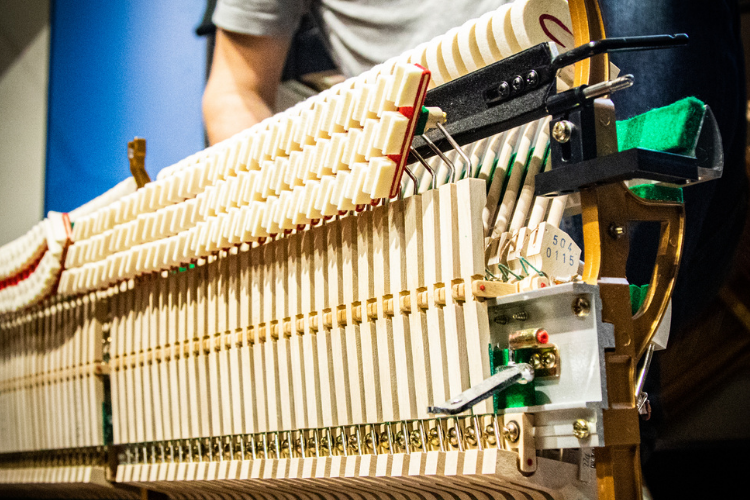There are many components that go into creating any piano and even the subtlest of changes can have some rather dramatic effects on the instrument. Perhaps the biggest of these however is the piano action.
Many are unaware that both grand and upright pianos use completely different mechanisms when it comes to striking the strings on the instrument and it is this change that can vastly affect aspects such as the speed of repetition and the ability to express on the instrument.
Today we’ll be investigating the two, what each one brings to the table as well as a few of their individual pros and cons.
What Does An Action Do?
In its most basic form, the piano action is the part of the piano that connects the keys to the hammers that strike the string; the action is what leverages the hammer and helps it return to its original resting place. This may sound rather straightforward however the piano action is possibly the most sensitive and delicate part of the instrument and is made up of hundreds of tiny parts and even the slightest slip or bit of damage can completely derail the tone or functionality of the instrument, as such, make sure you don’t touch your piano’s action, this is an incredibly specialist job. Learn more about piano technicians here!
The main difference between upright and grand actions is that a grand action is laid horizontally and underneath the strings, where an upright piano action is vertical and positioned in front of the strings, we will now break down both how these mechanisms work and what each one excels and compromises in.
Grand Piano Actions:
Starting off with the mighty grand, the grand piano action is generally considered superior to that of the upright as this action uses gravity as its main driving force. This means that a grand piano action typically has a better level of repetition (meaning notes can be played far quicker) and can be played with an immense level of accuracy to deliver the intended sound of the pianist.

As they are gravity based, some grand piano actions are able to feature what is known as a ‘double escapement’, meaning that even when the key is pressed and as it is lifted, the repetition lever on the action has already returned, meaning the key can be pressed quickly without needing to be fully reset.

Because of their size, grand pianos are also not only louder due to having longer strings and a larger soundboard, but because they are also able to house a longer keystick and action, the ‘see-saw’ of the action is far longer, this too means that more nuance and delicacy can be placed into the piano, meaning that even the softest of touches can be picked up by the instrument.
This being said, grand piano actions of course do make some compromises on the instrument, the most apparent being size. Where an upright piano can be easily stored in a corner or in far smaller spaces, grand pianos are fixed sizes and will often take up an entire room or section of a room, meaning they are not always suitable for most homes.
Likewise, due to the popularity and innovation of upright piano actions, older grand piano actions will not be as sophisticated as newer upright piano actions (for example the C.Bechstein Concert 8 is widely regarded as one of the most fantastic actions on the market, between both grand and upright pianos).
The final point to make regarding grand pianos is that they are significantly more difficult to keep clean! As they are far more exposed than that of uprights, dust and debris falling into the soundboard is a far more common issue for grand piano owners. These areas are particularly difficult to reach such as under the strings, and into the action.
Upright Piano Actions
Upright piano actions, whilst ultimately trying to achieve the same goal as their grand brothers, couldn’t be more different in design. The vertical nature of the upright piano makes the action far more complex and delicate. Where the grand piano works based on gravity, the upright piano is operated by a series of springs that essentially ‘fling’ the hammer forwards, striking the strings.

As a result of the reset being spring based instead of gravity based, the repetition of an upright piano is generally slower than that of an upright piano and is slightly less consistent. This is particularly due to the fact that upright pianos do not generally have this double escapement mechanism (however some high end C.Bechstein upright pianos do). This is known as single escapement and means that the key has to be almost fully released in order to reset the key.

This is mostly only noticed in more advanced playing where if the action is not sophisticated enough it won’t be able to repeat quickly enough for the passage, leading to missed notes, but for the casual player, you’ll likely not notice this too much.
This all being said, where upright pianos lack the full touch response that grands can offer, they are of course not only more compact than the grands so more suitable for home use, but also generally come in at a more modest budget due to fewer material being required during production. Learn more about selecting the right sized piano for your room here.
It is also worth noting that it is far easier to fit upright pianos with the likes of silent piano systems, meaning they can be played fully silently if required. Learn more about silent piano technology here.
We hope you have found this quick guide useful and interesting and if you are looking into either upgrading your current piano or purchasing your first piano, our experts are here to help!
Contact our showroom team here or visit our showroom to book a piano demonstration today!

